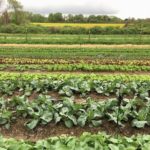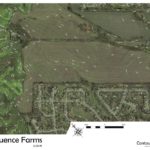- Location: Unincorporated St. Louis County, Missouri, USA.
- Site: Historic farmland and forest, 240 acres.
- Status: Initiated Winter 2019, completed Spring 2022.
- Scope: Whole property design for ecosystem restoration and regenerative agriculture.
Straddling the bluffs high above the Missouri River, Confluence Farms sits just upstream of where the great Missouri and Mississippi Rivers converge. Forested from the blufftops down to the river, with sloping croplands draining in the opposite direction, the property is a diverse mixture of relatively healthy wildlands and intensively used and degrading human spaces. The farm is the largest of its size in an otherwise suburbanized landscape. Comprised of deep loess soil that wind deposited on the river bluffs over many hundreds of years, the depth and productive capacity of the soils makes for some of the finest agricultural land anywhere on earth. Combine the fine soils with the steep topography of the land and the primary challenge of the property is apparent—protecting the fine, easily erodible soils from washing away. With such fine soils, decades of heavy tillage for monoculture corn and soy significantly eroded the land into rills and gullies throughout the property. To abate this, the evident solution is to cease the conventional agricultural methods while intentionally re-vegetating and healing the gullies. Longer term, the appropriate combination of land use practices must take over to rebuild the ecological health of the land. A thorough site assessment has uncovered options for what those practices might look like and suggests structural changes to the landscape that will set the stage for regeneration.
As of spring 2021, all former corn and soy field acreage (125 acres) had been put into perennial cover crops, starting the rebuilding of soil on the farm. Riparian buffers have been planted along erosion gullies, and the beginnings of tree crop planting has commenced. The 7-acre parcel we identified for market farming is in full swing serving as a cooperative farming enterprise to affordably supply fresh food to low-income communities, as well as to create a hub of activity that provides land access for developing farmers, learning and tool sharing amongst a diverse community of growers, and togetherness as we work with the earth to create livelihoods and heal ecosystems at the same time.
Real Earth Design completed permaculture design work for the entire 240 acres of the farm in Spring 2022.























